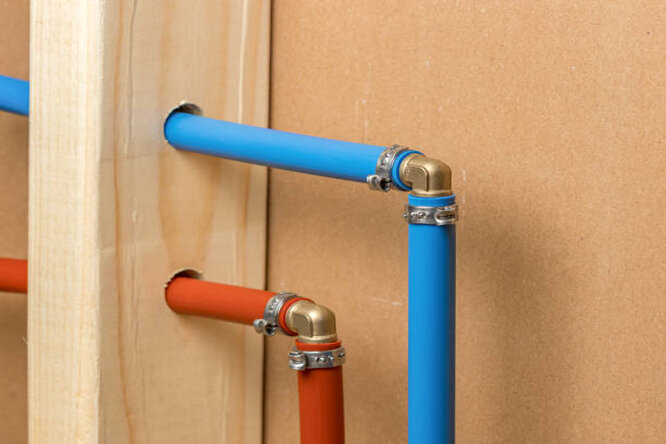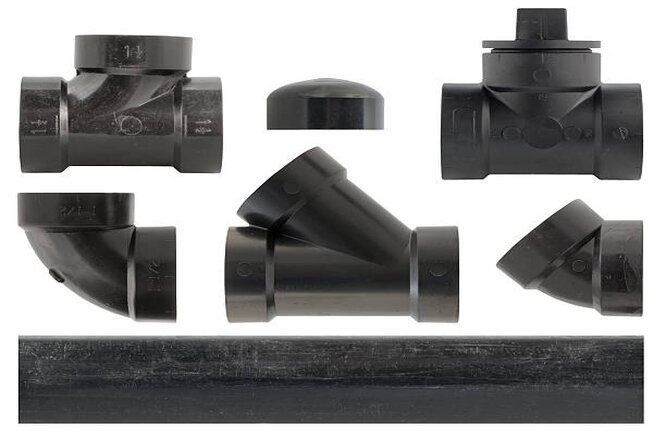Plumbing pipes are used all around the home to carry fresh water in and waste water out of the house. Many types of plumbing pipe materials are on the market today, e.g., Copper, PVC, PEX, etc.
That said, like many other engineering decisions, the best option or material would rely on certain criteria. You must consider the application, the project condition, and the advantages and limitations of the material you are using..
This article will provide an overview of today’s most common plumbing materials. I will also highlight the advantages and limitations of each of the plumbing pipe materials.
Types of plumbing pipe material
1. Polyvinyl chloride piping (PVC)

PVC is a versatile thermoplastic material commonly used for plumbing. Experts commonly use PVC for sink, toilet, and shower drain pipes because of its versatility, lightweight, and blockage resistance. This material is suitable for buildings with a high water supply and wastewater drainage demand.
Pros
- Rust and corrosion-resistant
- Affordable
- Resistant to high water pressure
- Resistant to blockage
- Strong and durable
Cons
- Because of its nature, PVC cannot be used for hot water
- Size limitations
- Not recyclable
- Prone to leakage if not connected properly
2. PEX pipes

Cross-Linked Polyethylene Piping, or PEX, is another popular piping material. They are extremely flexible and are similar to water hoses, and they can weave through walls, ceilings, basements, etc. This plumbing pipe material is best for areas with acidic water because it is more conducive.
Pros
- Extremely flexible
- Heat resistant
- Freeze resistant
- Nonconductive
- Easy installation
Cons
- Susceptible to ultraviolet rays and cannot be used outside
- Chemicals within PEX pipes leach into the drinking water
3. ABS piping

Acrylonitrile butadiene styrene (ABS) piping is very similar to PVC but can be distinguished by its unique black color. They are popular for their insane resilience to cold temperatures and extremely long lifespan. Use ABS piping for extremely cold areas or areas that do not directly face sunlight.
Pros
- Resistant to cold temperature
- Installation Is very easy
Cons
- Warps when exposed to direct sunlight
- ABS can be very noisy as it doesn’t contain the sound of water running through it
4. Copper pipes

Ever since the 1960s, people have used copper pipes, and they continue to use them to this day. Copper pipes are durable, reliable, and withstand high water pressure. Areas directly connected to sanitary municipal water supply systems use copper pipes.
Pros
- Environmentally friendly
- Extremely long lifespan
- Corrosion-resistant
- You can recycle old pipes
- It does not contaminate the water that runs through
Cons
- Expensive
- Not as flexible as other piping materials
- Because of its size, it is not applicable in tight places
5. Cast iron and galvanized steel pipes

Cast iron and galvanized steel pipes are not as common as they were years back but are still used for residential projects. They are heat-resistant, and incredibly durable, cast iron and galvanized steel pipes also reduce the sound of moving water. This type of plumbing pipe is preferred for outdoor applications.
Pros
- Incredibly strong
- Extremely durable
- Heat-resistant
- Reduces the sound of water running through the pipe
Cons
- Prone to rust and corrosion
- Can pass lead into the water supply
FAQs
What type of plumbing pipe lasts the longest?
PVC has the longest lifespan among all plumbing pipe materials, with an indefinite lifespan.
What type of plumbing pipe is safest?
Copper pipes are the safest as they don’t leach chemicals into your drinking water.
What type of plumbing pipe material is the cheapest?
The cheapest type of pipe material is PVC (polyvinyl chloride) pipe.
In conclusion – The best types of plumbing pipe
In general, copper pipes are the best type of plumbing pipes to use. This is mainly because they do not contaminate the water that runs through them. But as I mentioned earlier, choosing the best plumbing pipe for your project is an engineering decision.
It is recommended to get in touch with a professional consultant to learn about which material would be best suited for your project. This way, you can be certain that your project uses the most suitable pipe material that meets building codes, is safe, and meets your budget.
I hope you found this article helpful. You might also be interested in this article about female plumbers, their career prospects, job descriptions, annual income, and how to become one.
Thanks for reading.